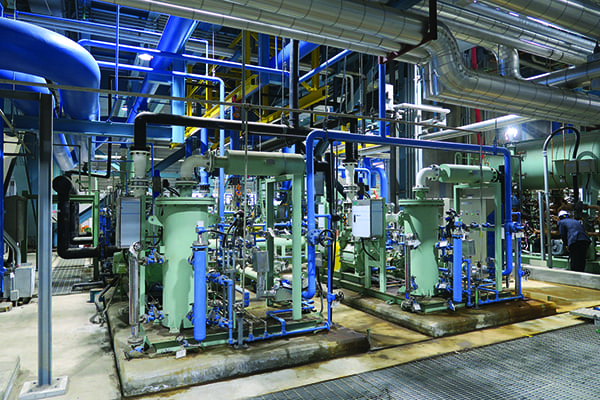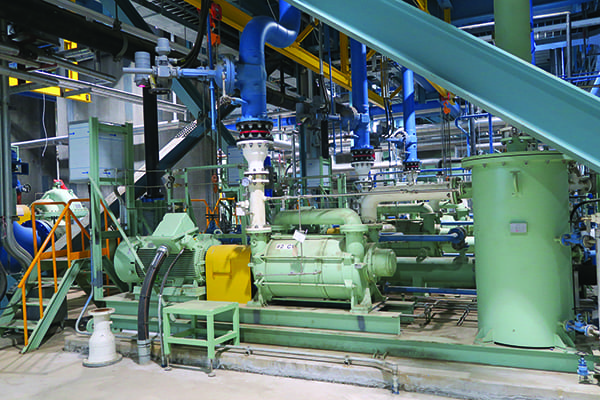Increase Condenser Efficiency with Latest-Generation Vacuum Pumps
State-owned Korea Midland Power Co. (KOMIPO) operates the Shin Boryeong Thermal Power Plant (TPP), a two-unit, 2,000-MW ultrasupercritical bituminous-coal-fired power plant. Shin Boryeong TPP is an extension to the Boryeong Thermal Power Site Division, the largest coal-fired power station complex in Korea, located in Boryeong, Chungcheongnam-do, South Korea.
The first 1,000-MW unit at Shin Boryeong TPP was commissioned in June 2016. The second unit was commissioned in November 2016, joining other existing power stations at the Boryeong Thermal Power Site Division that have been used to create a national industrial complex. There are 10 units and the coal-fired power stations generate 7,800 MW in total.
The Shin Boryeong TPP, with its ultrasupercritical energy technology, has achieved considerable improvements in plant efficiency while drastically reducing coal consumption. The plant has increased its steam pressure to 265 kg/cm 2 (260 bar), a result of the high temperatures of 610C and 621C used for the main and warming steam.
Besides highly efficient power generation, reducing environmental impact is also important for KOMIPO, and the technology in use at Shin Boryeong TPP allows for a considerable reduction in CO2, SOx, and NOx emissions in comparison with older power plant units.
Drawing and Maintaining Vacuum
KOMIPO uses Busch mechanical vacuum systems equipped with the latest generation of Dolphin liquid ring vacuum pumps to evacuate leaked air from the surface condensers in each of the two units at Shin Boryeong TPP, which has ensured an optimal efficiency factor for the steam turbines and helped increase efficiency and reduce energy costs. The Busch systems are used for the initial evacuation startup process (hogging) and the constant evacuation process (holding).
Incidental leaked air is constantly evacuated (holding) from the condenser by means of three identical vacuum systems (Figure 1), each with a two-stage Dolphin liquid ring vacuum pump. Each vacuum pump has a pumping speed of 3,700 cubic meters per hour and an ultimate achievable pressure of 33 millibar. Three vacuum systems are required because the power station operates in “winter operation” and “summer operation” modes. The power station is subject to both ambient temperature and seasonal fluctuations because the cooling water is taken from the sea.
While in winter mode, the ambient temperature and cooling water temperature are lower, which means there is less need to evacuate leaked air because the condenser is operating under optimal conditions. Therefore, only one of the vacuum systems is in use during winter operation.
When temperatures are higher, a second vacuum system is activated so that more incidental leaked air can safely be evacuated. This is usually the case during the summer months.
The third vacuum system with Dolphin liquid ring vacuum pumps purely acts as a standby for holding as well as providing increased pumping speed during the hogging phase, when all three pumps operate in parallel. By implementing all three vacuum systems in the overall control system for the steam turbines, they can be hooked up or shut down in a fully automated manner.
As air continually needs to be evacuated from the condenser, at least one of the three vacuum systems must be in operation at all times, and the control system must be programmed so that all three vacuum systems operate intermittently. In this way, all three vacuum systems will operate for the same number of hours.
Maintaining a constant vacuum level in the condenser also helps to remove the vapor from the turbine, so that the turbine does not need to operate against backpressure when starting up—which is favorable for the efficiency factor.
Waterbox Priming
Two additional vacuum systems with single-stage Dolphin liquid ring vacuum pumps (Figure 2) are used for the condenser waterbox priming application. These systems are similar in terms of their construction, but the Dolphin sizes used here are smaller. They operate with a pumping speed of 1,230 cubic meters per hour in each case and an ultimate pressure of 130 millibar.
 |
| 2. Priming the system. These two vacuum systems with single-stage Dolphin liquid ring vacuum pumps are used for condenser waterbox priming. Courtesy: Uli Merkle, Busch Dienste GmbH |
The systems also have been integrated in the overall control system. During an initial degassing, both vacuum systems operate simultaneously. They create a vacuum and evacuate the condenser water boxes, which lifts cooling water to flood the cooling side of the condenser, after which the pumps stop.
In everyday practice, one of these vacuum systems operates for a short time, running two or three times each day to re-prime the condenser by removing additional dissolved air that is released from the cooling water as it rises in temperature through the condenser.
Benefits over Other Systems
Multi-stage steam ejectors with an intermediate condenser were used for these applications in the past. Today, the mechanical Dolphin liquid ring vacuum pumps have become more established as reliable and effective vacuum generators.
Power station operators and those who build power plants are increasingly opting for liquid ring vacuum technology for obvious reasons. Multi-stage steam ejectors require considerably more space and are costly to install. They also require steam, which needs to undergo several intermediate condensing processes.
Seawater is used as the cooling fluid for the Dolphin liquid ring vacuum pumps. The vacuum systems’ heat exchangers are therefore made of corrosion-resistant materials and in the waterbox priming system the actual vacuum pumps and the entire systems are made of corrosion-resistant materials.
The operating fluid is pumped through the circuit and cooled via a heat exchanger. A discharge separator allows pumped gases to be vented to exhaust while separating the operating liquid to be re-used by recycling back to the vacuum pump. The operation of the vacuum systems is virtually maintenance-free. They are overhauled once a year, when the power station is taken offline for two to three weeks in order to complete general maintenance work.
As this project has only involved Korean companies, KOMIPO has worked with Busch Korea Ltd., part of the international Busch Group that supplies vacuum technology for a wide range of industrial applications. Dolphin vacuum systems are specifically tailored to the requirements of the particular application in each case, with the engineering, design, and assembly of the vacuum systems all carried out at Busch Korea.
—Uli Merkle is head of marketing services for Busch Dienste GmbH in Germany.
